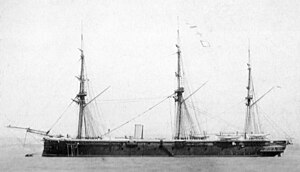HMS Resistance (1861)

Sister ship Defence at anchor
|
|
| History | |
|---|---|
|
|
|
| Ordered: | 14 December 1859 |
| Builder: | Westwood, Baillie, Poplar, London |
| Cost: | £258,120 |
| Laid down: | 21 December 1859 |
| Launched: | 11 April 1861 |
| Completed: | 5 October 1862 |
| Commissioned: | July 1862 |
| Decommissioned: | 1880 |
| Nickname(s): | Old Rammo |
| Fate: | Sold for scrap, 11 November 1898 |
| General characteristics | |
| Class and type: | Defence-class armoured frigate |
| Displacement: | 6,070 long tons (6,170 t) |
| Length: | 280 ft (85.3 m) |
| Beam: | 54 ft 2 in (16.5 m) |
| Draught: | 26 ft 2 in (8.0 m) |
| Installed power: | |
| Propulsion: | 1 shaft, 1 Trunk steam engine |
| Sail plan: | Ship rig |
| Speed: | 11 knots (20 km/h; 13 mph) |
| Range: | 1,670 nmi (3,090 km; 1,920 mi) at 10 knots (19 km/h; 12 mph) |
| Complement: | 460 |
| Armament: |
|
| Armour: | |
HMS Resistance was the second of two Defence-class ironclads built for the Royal Navy in the 1860s. She was the first capital ship in the Royal Navy to be fitted with a ram and was given the nickname of Old Rammo.Resistance was initially assigned to the Channel Fleet upon commissioning, but was transferred to the Mediterranean Fleet in 1864, the first ironclad to be assigned to that fleet. She was rearmed in 1867 and became a guardship when recommissioned in 1869. The ship was reassigned to the Channel Fleet in 1873 before reverting to her former duties in 1877. Resistance was decommissioned in 1880 and was used for gunnery and torpedo trials beginning in 1885. The ship was sold for scrap in 1898 and foundered in 1899 en route to the breaker's yard. She was salvaged and later scrapped.
The Defence-class ironclads were designed as smaller and cheaper versions of the Warrior-class armoured frigates. This meant that they could not fit the same powerful engines of the Warrior-class ships and were therefore 2 knots (3.7 km/h; 2.3 mph) slower and had far fewer guns. The naval architect Sir Nathaniel Barnaby, a future Constructor of the Navy, considered that, in terms of combat, a Defence-class ship was worth one quarter of a Warrior.
HMS Resistance was 280 feet (85.3 m) long between perpendiculars and 291 feet 4 inches (88.80 m) long overall. She had a beam of 54 feet 2 inches (16.51 m) and a draft of 26 feet 2 inches (8.0 m). The ship displaced 6,070 long tons (6,170 t) and had a ram in the shape of a plough, the first capital ship in the Royal Navy to be fitted with one. The hull was subdivided by watertight transverse bulkheads into 92 compartments and had a double bottom underneath the engine and boiler rooms. Resistance was 128 feet 8 inches (39.2 m) shorter overall and displaced over 3,000 long tons (3,000 t) less than the Warrior-class ironclads.
...
Wikipedia
